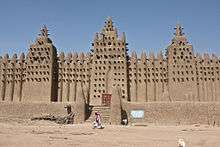Architecture of Mali
The architecture of Mali is a distinct subset of Sudano-Sahelian architecture indigenous to West Africa. It comprises adobe buildings such as the Great Mosque of Djenné or the University of Timbuktu. It can be found all over the Sahel region of Africa. Malian architecture developed during the Ghana Empire, which founded most of Mali's great cities. They then flourished in West Africa's two greatest civilisations the Mali Empire and the Songhai Empire.

Great Mosque of Djenné
The Great Mosque of Djenné was first built in the 13th century. It is an example of Sudano-Sahelian style and has been an integral part of the Malian community for almost a millennium.
Timbuktu
Timbuktu has many adobe and mud brick buildings but the most famous is the University. The masajids (mosques) of Sankore, Djinguereber, and Sidi Yahya were the centres of learning in medieval Mali and produced some of the most famous works in Africa, the Timbuktu Manuscripts.
References
- Elias N. Saad, Social History of Timbuktu: The Role of Muslim Scholars and Notables 1400–1900. Cambridge - London - New York 1985.
- Shamil Jeppie & Souleymane Bachir Diagne (eds). The Meanings of Timbuktu. HSRC Pess: Cape Town, 2008
- "The University of Sankore, Timbuktu". Foundation for Science, Technology and Civilisation.